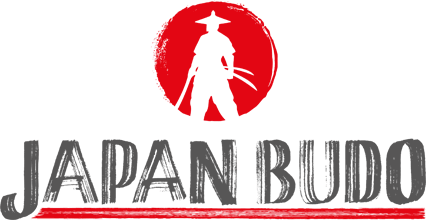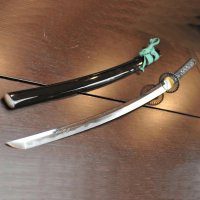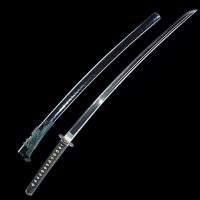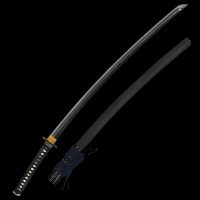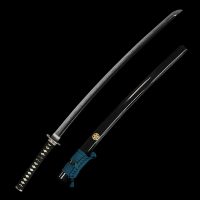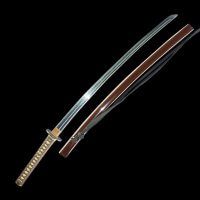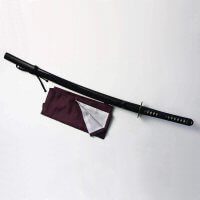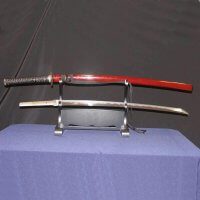Nihonto Budo
Genuine swords from Japan from the recent past. These are modern works, i.e. Gendaito. Such swords are usually used for Iai and Tameshigiri, but they are also ideal as art and collector's items! (We list antique nihonto in our Category for antique swords)
Many of the swords offered here are from current, often still living master smiths. You are also welcome to order a completely new sword from Japan from us!
Showing all 7 resultsSorted by popularity
Showing all 7 resultsSorted by popularity
The real sword from Japan is called Nihonto. The name is made up of the characters Nihon (=Japan) and To (=sword).
Many sellers use this term for the successful sale of replicas and counterfeits. With us you get the original. The real sword from Japan.
If you are looking for antique originals, you will find them in the category for antique samurai swords.
If you would prefer a completely new centreboard tailored to your needs, please use our Nihonto configurator.
What are the properties of Nihonto?
![]() =Nihonto: The basic characteristic of these swords is that they were really made in Japan! These swords are made with dedication, patience and precision.
=Nihonto: The basic characteristic of these swords is that they were really made in Japan! These swords are made with dedication, patience and precision.
They embody a part of Japanese culture and are also an important part of history. Many Japanese families keep their swords as their family's greatest treasure.
This makes an impression on people all over the world and there is also an increasing number of people here who would rather keep a respectable piece of home for themselves than, for example, show off the latest car model to their neighbours.
The swords are based on the forging tradition of Japanese master blacksmiths, which has been passed down from generation to generation for centuries and has even been expanded with modern scientific findings.
Despite this modern knowledge, the manufacturing methods are traditional and forging is still carried out today according to historical models.
As there are many different types of Japanese swords, they also have different characteristics.
However, there are a few similarities with the Japanese swords. For example, real Tamahagane steel from Japan is used to make the blades and magnolia wood is used for the scabbard.
The forging process in particular is similar for most swords, traditional and of the highest standard.
Nihonto therefore indirectly means that it is a sword at the highest level of an esteemed craftsmanship.
Buying Nihonto - why is it so difficult?
There are a few points that can complicate the purchase of a Nihonto.
Japanese swords must come from licensed swordsmiths in order to be exported from Japan.
Only a relatively small number of people have this swordsmith licence and it is subject to strict conditions. For example, a blacksmith may only forge a limited number of Nihonto per year.
This alone limits the availability of new Nihonto.
In addition, there is an export procedure that, like so many things in Japan, is associated with very extensive bureaucracy.
To make matters worse for buyers, there are many "Nihonto" products available on the Internet these days.
Some of the swords on display look good and are attractively presented. In reality, however, they are not swords from Japan.
Finding a reputable and reliable dealer is perhaps more difficult than ever. We would like to become your partner for the purchase of Nihonto.
Buying Nihonto is a unique opportunity to experience the art, history and power of Japanese swords.
Immerse yourself in the world of these exquisite swords and discover the beauty and elegance of the fascinating specimens in our extensive range.
With our expertise and passion for traditional Japanese swordsmanship, we will be happy to help you choose your dream nihonoto.
Which Nihonto you can buy at Japan-Budo
We offer you an impressive selection from Nihonto. Our antique swords from Japan you may have already seen.
There you will find swords from different eras of Japanese history categorised into different sword types.
In this category you will find somewhat younger examples. These often date from the time after sword-carrying was banned in Japan. But we also endeavour to have an assortment from the production period after the Second World War.
Immediately after the war, the manufacture of swords in Japan was banned by the occupying USA.
Fortunately, the production of new swords was soon resumed.
As the blacksmiths of the past and present forge according to the old traditions, the newer productions are also of high quality and masterly.
New models can therefore be just as expensive as old swords from Japan. In some cases, they are even considerably more expensive. It always depends on which models you are comparing.
The price is determined by the quality of workmanship of the blade, not just its age.
If you cannot find the right sword for you in these categories, we work together with a selection of sword smiths in Japan from whom you can order your own customised sword from Japan.
For such newly manufactured swords (Japanese: Shinsakuto) you will find a separate Katana configurator on our homepage.
The production of such a modern Nihonto has the advantage that the sword is completely customised to your specifications. No wishes remain unfulfilled and everything is of course of exceptional quality.
Which swords are used for Japanese swordsmanship training?
In addition to the blunt training swords with aluminium blades, also known as Iaito, advanced students are allowed to train with real swords.
These swords are known as Shinken Katana, or simply Shinken. Unlike the usual training swords, they have a sharp blade and are therefore only permitted in training for people who can handle them and do not pose a danger to themselves or others.
The difference to other Nihonto
Training means that the sword becomes "worn" over time. Over time, such training swords develop typical symptoms such as small, superficial scratches on the blade or minimal play between the handle and the other attachments.
For this reason, everyday training does not usually involve the use of antique swords from Japanbut modern productions. Also those with the symptoms described above, as they occur over time anyway and the affected swords are much cheaper to buy.
Why a sword from Japan for training?
Training in Japanese swordsmanship actually requires a real sword from Japan.
Anyone who is advanced enough to be allowed to train with a sharp sword usually has such a deep connection to the motherland of Japanese martial arts that a sword from Japan is a must.
In Japan, katana and other swords are still made today as they were in the days of the samurai.
Even if products from China, for example, are much cheaper due to modified production methods, only a genuine sword from Japan is really suitable for real training in Japanese swordsmanship.
What are typical characteristics of Nihonto for Iai and Tameshigiri?
The modern swords of today's Japan are characterised by the fact that the blades are relatively hard. Especially for tameshigiri, this characteristic is advantageous compared to ancient nihnoto.
